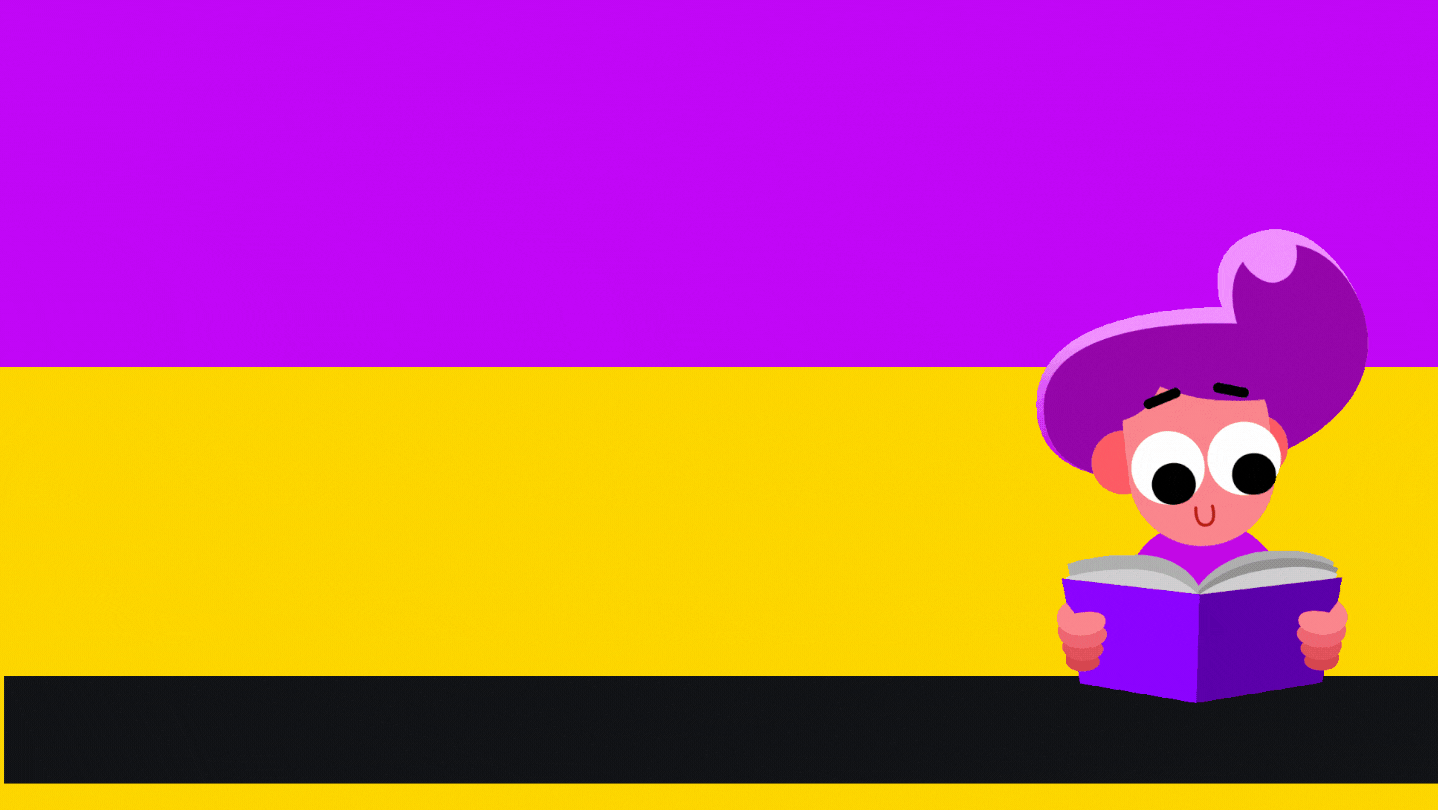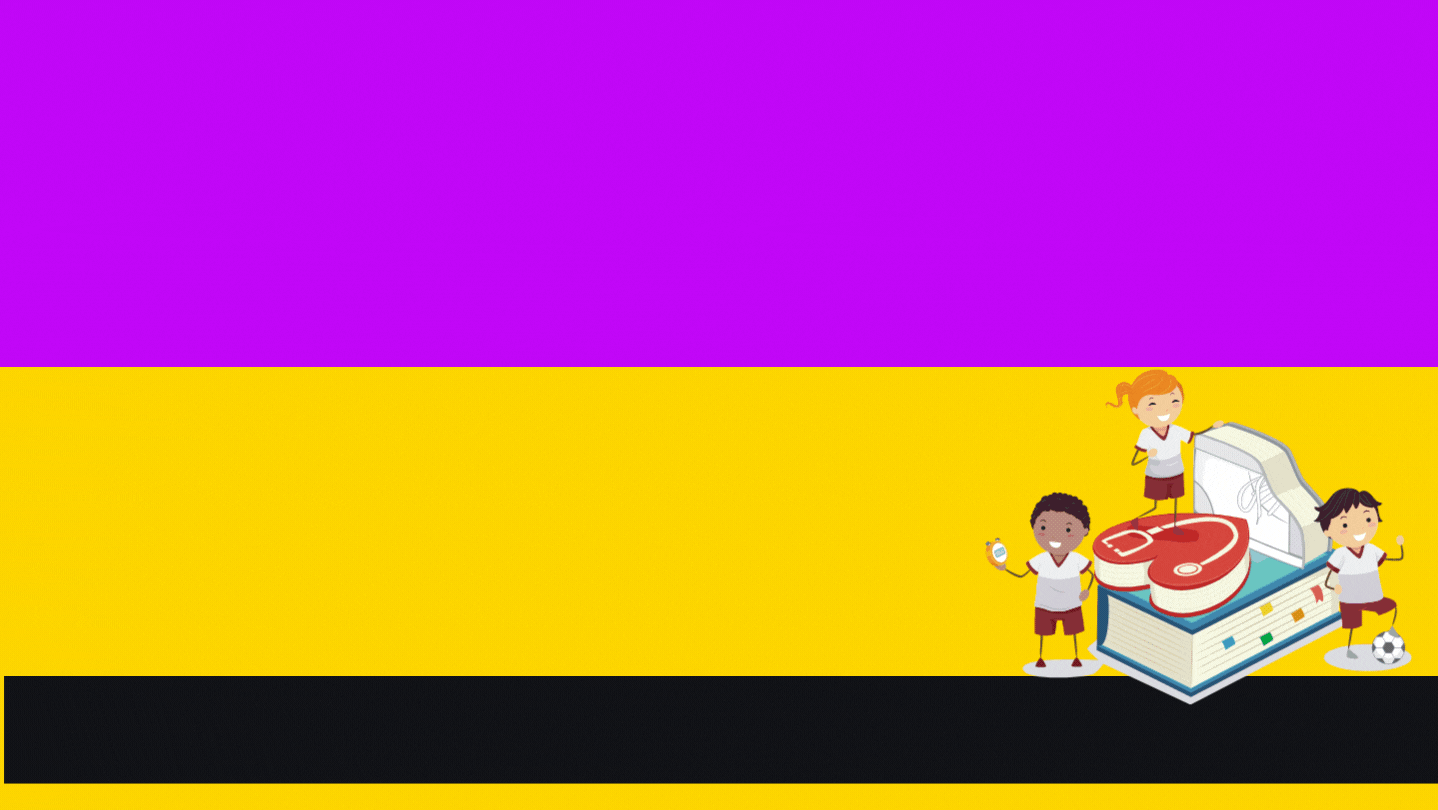Search results: 114
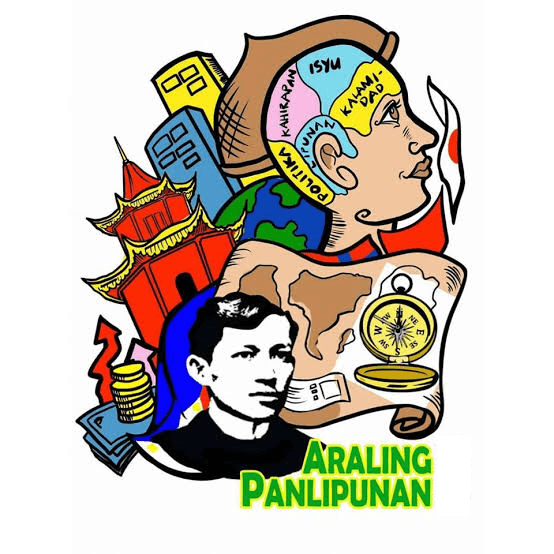
174004 Grade 9-Diamond-Araling Panlipunan
Ang Araling Panlipunan ay pag-aaral ng mga tao at grupo, komunidad at lipunan, kung paano sila namuhay at namumuhay, ang kanilang ugnayan at
interaksyon sa kapaligiran at sa isa’t isa, ang kanilang mga paniniwala at kultura, upang makabuo ng pagkakakilanlan bilang Pilipino, tao at miyembro ng lipunan at mundo at
maunawaan ang sariling lipunan at ang daigidig, gamit ang mga kasanayan sa pagsasaliksik, pagsisiyasat, mapanuri at malikhaing pag-iisip, matalinong pagpapasya, likaskayang paggamit ng pinagkukunang-yaman, at mabisang komunikasyon. Layunin ng Araling Panlipunan ang paghubog ng mamamayang mapanuri, mapagmuni,
responsable, produktibo, makakalikasan, makabansa, at makatao, na may pambansa at pandaigdigang pananaw at pagpapahalaga sa mga usapin sa lipunan sa
nakaraan at kasalukuyan, tungo sa pagpanday ng kinabukasan.
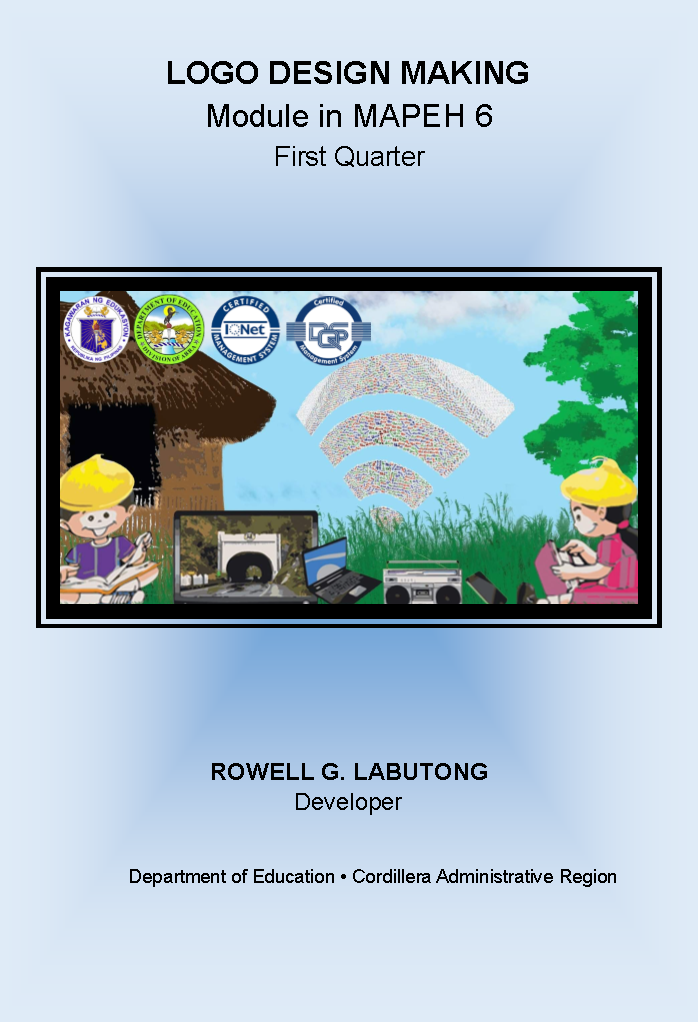
135149_BOLBOLO ELEMENTARY SCHOOL_MAPEH-ARTS 6_QUARTER 1-WEEK 3: LOGO DESIGN MAKING
This module is intended for Grade 6 pupils that aims to improve pupil’s performance specifically MAPEH-ARTS in creating personal or class logo. This material would empower pupils to be competent in learning how to learn and develop life skills that make him/her a self-developed person. It also enables them to become active constructors of knowledge and not passive recepient of information.
This module open avenues for pupils to know more about themselves as well as acknowledge their limitations and encourage them to do something about these limitations. It is a learner-friendly because the excercises are so designed to have orderly progressions of skills. It has several sets of activities. Pupils become self-directed learners as they work independently following the directions given in the module.
This module objectively discusses how to create personal or class logo as visual representation that can be used as a product, brand, or trademark.
135545Grade4 Edukasyon sa Pagapakatao
This Intervention and Supplementary Enhancement Material (ISEM) is a project of the Curriculum Implementation Division, Schools Division of Benguet, Cordillera Administrative Region which is in response to the implementation of the K to 12 Curriculum.
This Learning Material is a property of the Department of Education- CID, Schools Division of Benguet. It aims to assess learners’ performance in all learning areas per grade level.

135631_Grade 5_SCIENCE_Kezia Lynne P. Bagayao

BLAST OF TO THE MOON!
Supplementary activities about the phases on the moon for kids in the 5th grade!
FOCUSED SKILL
• Distinguish between waxing and waning
• Identify which phase of the moon occurs in various locations in its orbit around the Earth
Infer the pattern changes in the appearance of the moon. S5FE-IVg-h-7
SUBTASKS
• Identify and describe the different phases of the moon
• Illustrate and arrange the phases of the moon orderly.

135704-Paran Laruan Elementary school-Grade 5-Q1:Module 1:Mixture
This module will serve as a guide in your continuous exploration of science. It will be your aid as you learn new ideas and enrich your existing knowledge of scientific concepts and principles through various challenging activities about mixtures and its classification
Lessons in this module will be divided into:
Lesson 1- Characteristics of Mixture
Lesson 2- appearance of Uniform(Homogenous) mixture
Lesson 3- Appearance of non-Uniform(Heterogenous) Mixture
Lesson 4- Classification and Uses of Mixtures
After going through this module, you are expected to:
* Explain what mixture is;
* Identify the appearance of uniform(Homogenous) mixture;
* describe the appearance of non-uniform(Heterogenous) mixture;
* Classify mixtures into uniform(Homogenous) and non-uniform(Heterogenous) mixture;
Name common household mixtures.
Develop communication, critical thinking, creativity, collaboration and character
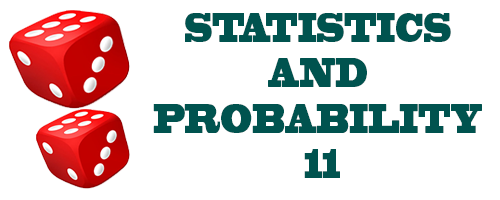
302446-Alimodian National Comprehensive High School-Statistics and Probability-Grade 11-Quarter 3-Module 1-Random Variable
As previously learned in Junior High School lessons, there are lots of wonders in nature or in real-life, like tossing a coin or rolling a die, whose outcomes cannot be predicted with certainty in advance, but the set of all the possible outcomes is known. These are what we call as random phenomena or random experiments.
A random experiment is a mechanism that produces a definite outcome that cannot be predicted with certainty. The set of all possible outcomes of an experiment is called the sample space. The sample space associated with a random experiment is the set of all possible outcomes. An event is a subset of the sample space.
Remember that a variable is a characteristic or attribute that can assume different values. We use capital letters to denote or represent a variable. A variable X whose value depends on the outcome of a random process is called a random variable. A random variable is a variable whose value is a numerical outcome of a random phenomenon. It is a capacity that connects a real number with every component in the sample space. It is a variable whose qualities are controlled by chance. In this manner, a random variable is a numerical amount that is derived from the results of an arbitrary trial or experiment.
A random variable can be discrete or continuous.
Discrete Random Variables are variables that can take on a finite number of distinct values.
Continuous Random Variables are random variables that take an interminably uncountable number of potential values, regularly measurable amounts.

302446-Alimodian National Comprehensive High School-Statistics and Probability-Grade 11-Quarter 3-Module 3:Values of a Random Variable
A random variable is a set of possible values from a random experiment. We use a capital letter, like X, Y, or Z to avoid confusion with the variables used in Algebra or we can use any letter in the alphabet.
A random variable has a probability distribution (will be discussed in the next activity sheet) that represents the likelihood that any of the possible values would occur. Let’s take for example that the random variable, X, is the number on the top face of a die when it is rolled once. The possible values for X will be 1, 2, 3, 4, 5, and 6. Another classic example of a random variable is the outcome of tossing a coin. We consider a probability distribution in which the outcomes of a random event are not equally likely to happen. If random variable, Z, is the number of tails we get from tossing three coins, then Z could be 0, 1, 2 or 3. This means that we could have no tails, one tail, two tails or three tails on a three-coin toss.
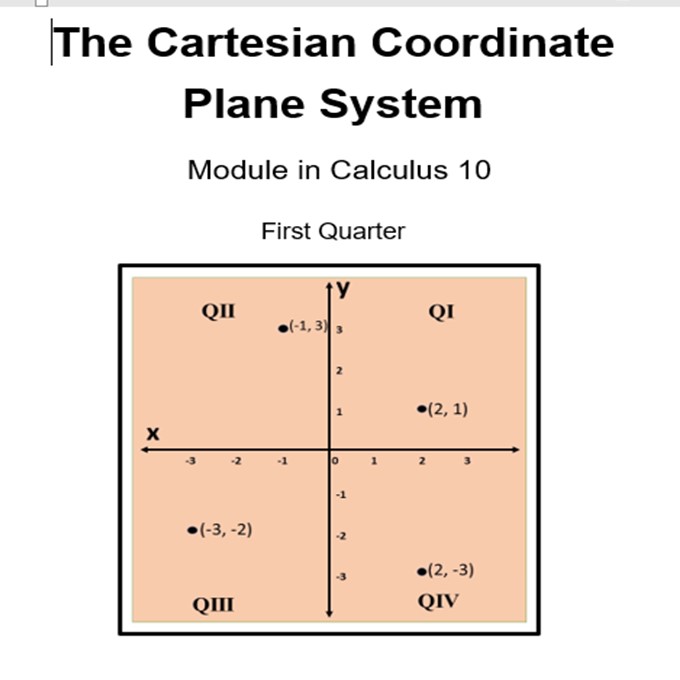
305107-Grade 10-Lovelace-Calculus
This module is for an independent learner. Kindly follow the stages of this module, do not skip any of the stages of the module unless it is stated in the direction. The parts of this module are pre-assessment test, lesson proper, generalization, application and post assessment.
After going through this module, you are
expected to:
expected to:
●describe
the concepts of the Cartesian coordinate plane system which include the
coordinate axes, ordered pairs abscissa, ordinate, quadrants and the origin
the concepts of the Cartesian coordinate plane system which include the
coordinate axes, ordered pairs abscissa, ordinate, quadrants and the origin
●plot ordered pairs of real numbers in
the rectangular coordinate system

305109-Grade 10-STE-EDUKASYON SA PAGPAPAKATAO
Ang tunguhin o ”outcome” ng pag-aaral sa batayang edukasyon ay ang panlahatang pag–unlad taglay ang mga kasanayan sa ika–dalawampu’t isang siglo.
Taglay ito ng isang mag-aaral kung mayroon siyang mga kakayahang pangkaalaman, pandamdamin at pangkaasalan na magbibigay sa kanya ng kakayahan
upang:
1. mamuhay at magtrabaho
2. malinang ang kanyang mga potensiyal
3. magpasiya nang mapanuri at batay sa impormasyon
4. makakilos nang epektibo sa lipunan at pamayanan sa konteksto ng sandaigdigan upang mapabuti ang uri ng kanyang pamumuhay at ng kanyang
lipunan (Literacy Coordinating Council, Setyembre 1997).
Ibinatay ang kahulugan at ang limang palatandaan nito sa Apat na Batayan (Pillar) ng Edukasyon at sa konsepto ng UNESCO tungkol sa mga panghabambuhay
na kakayahan (life skills) na binuo ng International Commission on Education para sa ika-21 siglo. Ang sumusunod ang limang palatandaan nito: (a) may
kakayahang makipagtalastasan, (b) nag-iisip nang mapanuri at may kakayahang lumutas ng suliranin, (c) ginagamit ang mga likas na yaman nang
mapanagutan para sa susunod na salinlahi at (d) produktibo, napauunlad ang sarili at ang pakikipagkapwa, at (e) may malawak na pananaw sa daigdig.
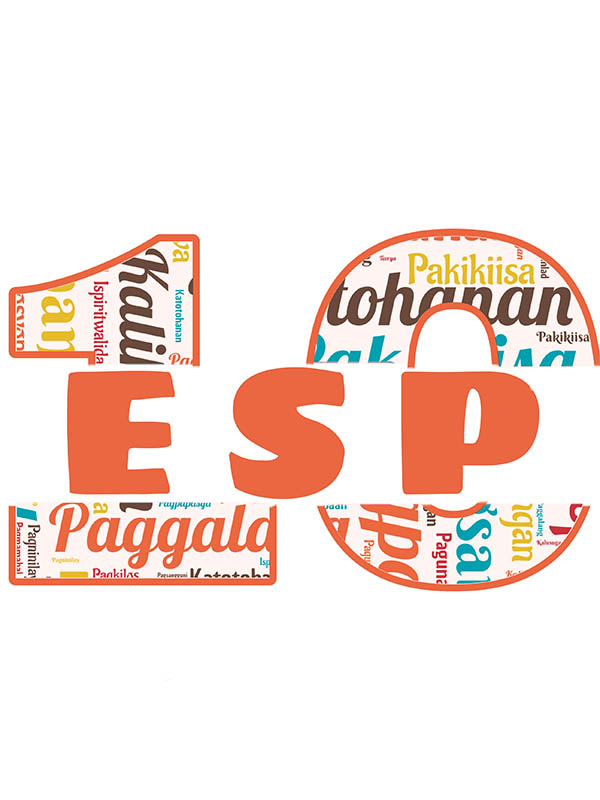
318904_GRADE 10A_EDUKASYON SA PAGPAPAKATAO
Naipamamalas ng mag-aaral ang pag-unawa sa mga konsepto tungkol sa pagkatao ng tao, makataong kilos, pagpapahalagang moral at mga
isyung moral at nagpapasya at kumikilos nang may preperensya sa kabutihan upang maging matatag sa gitna ng mga isyung moral at
impluwensya ng kapaligiran.

318904_Grade 8-A_ English
GRADE LEVEL STANDARDS: The learner demonstrates communicative competence through his/ her understanding of Afro-Asian Literature and other texts
types for a deeper appreciation of Philippine Culture and those of other countries.

318904-GRADE11-TVL-COOKERY
The learners
demonstrate an
understanding the
knowledge, skills, and
attitudes required in
preparing appetizers
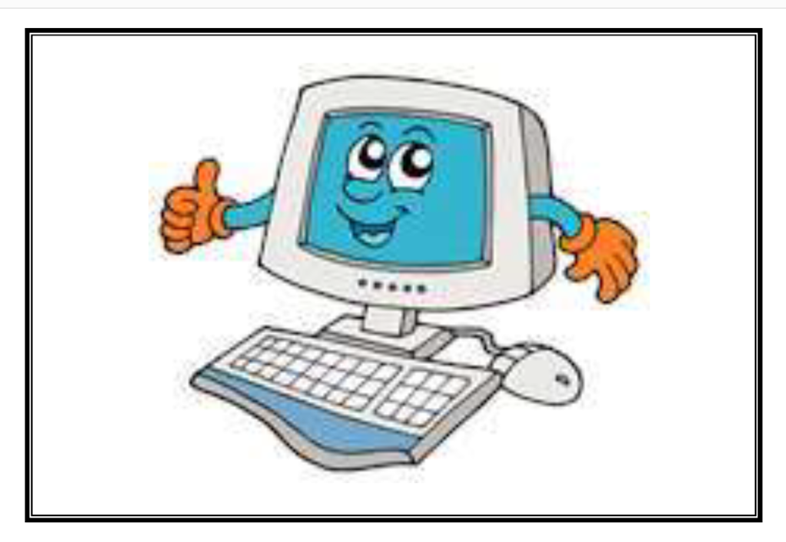
319217_Dacudac National High School_TLE ICT Exploratory 7_Quarter 1_Module 1: Computer Hardware Servicing
Welcome to the world of Computer Hardware Servicing!
This Module is an exploratory course which leads you to Computer Hardware Servicing National Certificate Level II ( NC II). It covers 4 common competencies that a Grade 7 Technology and Livelihood Education (TLE) student like you ought to possess, namely:
1) Use hand tools;
2) Perform mensuration and calculation;
3) Prepare and interpret technical drawing; and
4) Practice occupational health and safety procedures.
These 4 common competencies are covered separately in 4 Lessons. As shown below, each Lesson is directed to the attainment of two or more learning outcomes:
Lesson 1 – Use Hand Tools
Learning Outcome (LO) 1 - Prepare hand tools
Learning Outcome (LO) 2- Use appropriate hand tools and test equipment
Learning Outcome (LO) 3 - Maintain hand tools
Lesson 2 –Perform Calculation and Mensuration
Learning Outcome (LO) 1 - Select components to be measured
Learning Outcome (LO) 2 - Carry out measurements and calculation
Lesson 3 –Prepare and Interpret Technical Drawing
Learning Outcome (LO) 1 - Identify different kinds of technical drawing
Learning Outcome (LO) 2 - Interpret technical drawing
Lesson 4 –Practice Occupational Health and Safety Procedures
Learning Outcome (LO) 1 - Identify hazards and risks
Learning Outcome (LO) 2 - Evaluate hazards and risks
Learning Outcome (LO) 3 - Control hazards and risks
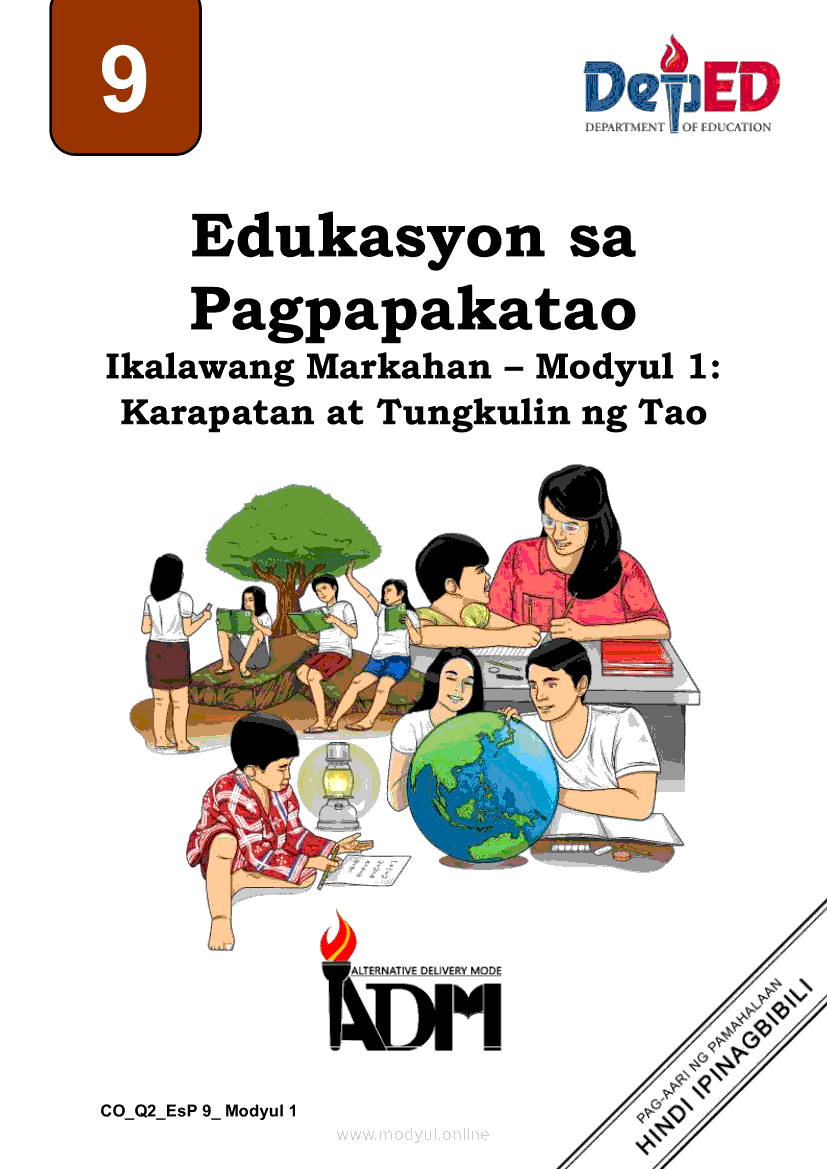
320304_Las Piñas City National Science High School_Edukasyon Sa Pagpapakatao 9_Grade 9_Quarter 2_Module 1_Karapatan at Tungkulin
Kahit na tayo ay mayaman o mahirap, lahat tayo ay may pantay-pantay na karapatan. Walang
sinuman ang may nakararaming karapatan kaysa sa iba. Mahalagang malaman mo rin ang mga
katungkulan at responsibilidad na kaakibat sa bawat karapatan.

Araling Panlipunan QUARTER 4-Grade 4-135524-HAYDEE BADOL PALENG
Naipagmamalaki ang pagka- Pilipino at ang bansang Pilipinas na may pagpapahalaga sa pagkakaiba-iba ng mga kulturang Pilipino batay sa paggamit ng mga
kasanayan sa heograpiya, pag-unawa sa kultura at kabuhayan, pakikilahok sa pamamahala at pagpapahalaga sa mga mithiin ng bansang Pilipinas.
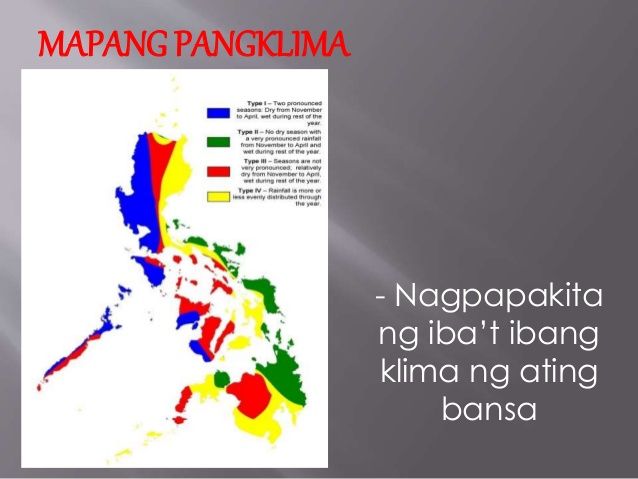
Araling Panlipunan_quarter1_135623
Ang mag-aaral ay...
Naipamamalas ang pang-unawa sa pagkakakilanlan ng bansa ayon sa mgakatangiang heograpikal gamit ang mapa.
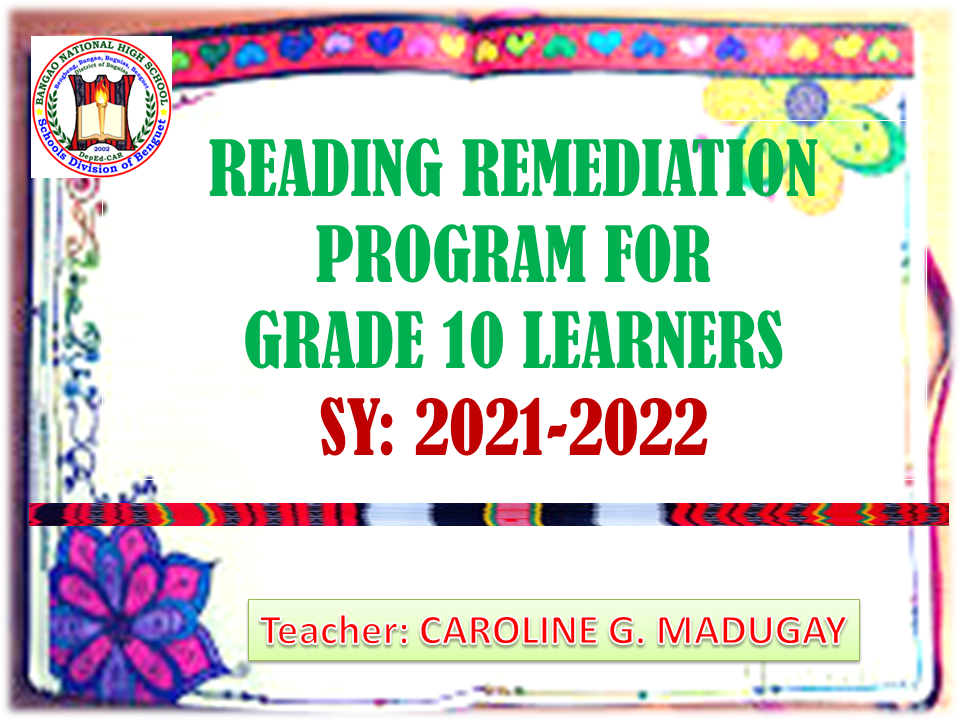
Assessment of Reading Comprehension for Grade 10 Learners_318902_BangaoNHS-TeacherCarolineMadugay
Bangao National High School support the Department of Education "Every child a Reader Program" which aims to make every Filipino Child a Reader and a writer at his /her grade level.
In response to the demand of helping the students achieve the aim of the Department of Education, there is a need to eliminate the difficulties in the oral and in reading printed materials. Continuing activities of interventions and remediation geared towards reading are conducted to help students enhance their comprehension and language competencies. But with the booming of technology this becomes the factor on the failure of students to focus and develop their reading habits. skills.In today's new normal setting, technology becomes an advantage for the learners in keeping with the 21st Century skills. Still, teacher needs not to neglect the situation of students and exert more to enable students to inculcate the love of reading which are vital as they journey in a higher education. So in-order to cope with the demand of technological and computerized world, teachers should provide students with maximum activities for them to understand the meaning of purposeful reading in term of speed and in comprehension.
Reading is a great habit which students need to develop, yet among the five basic communication skills which are as follows: reading, listening, speaking, viewing and writing- reading is the least given importance. One of the important ways of learning is reading. Thus, success in school and in life depends in large part of an individual’s ability to read.
This assessment aims to:
1. Increase
the performance of students in word recognition and in comprehension; 2. Develop
among the students the habit of reading
; 3. Enable
students who are experiencing difficulties in aspects of reading performance to
develop in appropriate ways; and 4. Inculcate
in the students the value of reading
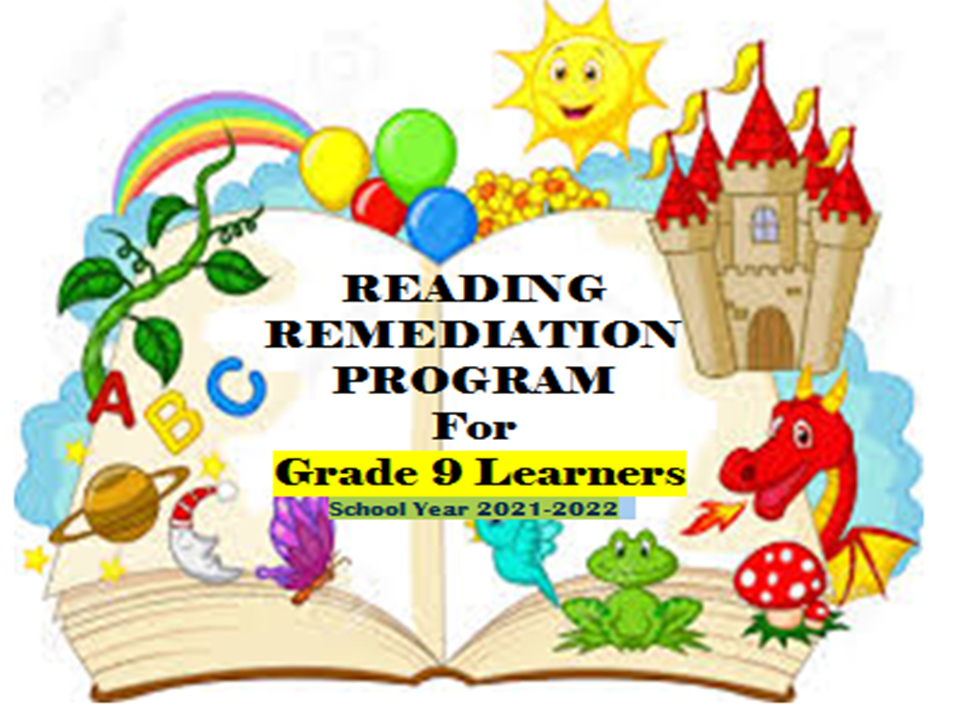
Assessment of Reading Comprehension for Grade 9_318902_BangaoNHS_TeacherCarolineMadugay
Bangao NHS supports "Every child a Reader Program" which aims to make every Filipino Child a Reader and a writer at his /her grade level.
In response to the demand of helping the students achieve the aim of the Department of Education, there is a need to eliminate the difficulties in the oral and in reading printed materials. Continuing activities of interventions and remediation geared towards reading are conducted to help students enhance their comprehension and language competencies. But with the booming of technology this becomes the factor on the failure of students to focus and develop their reading habits. But in today's new normal setting, technology becomes an advantage hence face-to-face is not yet allowed. Still, teacher needs not to neglect the situation of students and exert more to enable students to inculcate the love of reading which are vital as they journey in a higher education. So in-order to cope with the demand of technological and computerized world, teachers should provide students with maximum activities for them to understand the meaning of purposeful reading in term of speed and in comprehension.
Reading is a great habit which students need to develop, yet among the five basic communication skills which are as follows: reading, listening, speaking, viewing and writing- reading is the least given importance. One of the important ways of learning is reading. Thus, success in school and in life depends in large part of an individual’s ability to read.
The implementation of this reading Readiness program aims to:
1. Increase the performance of students in word recognition and in comprehension;
2. Develop among the students the habit of reading ;
3. Enable students who are experiencing difficulties in aspects of reading performance to develop in appropriate ways; and
4. Inculcate in the students the value of reading

Communication_Skills_Quarter3_Read Words and Prhases
This Learning Activity Sheet is a project of the Curriculum Implementation Division particularly the Learning Resource Management Development System (LRMDS), Department of Education, Schools Division of Apayao which is in response to the implementation of the K-12 Curriculum.
This learning material aims to improve LSENs’ performance in Communication Skills.
Date of Development : March 04, 2021
Resource Location : Flora East Central School, Flora, Apayao
Learning Area : Communication Skills
Grade Level : Non Graded, Level 2
Learning Resource Type : Activity Sheet
Language : English
Quarter/ Week : Quarter 3
Learning Competency/Code : Reads words/phrases c-v-c (a)

Disaster Readiness and Risk Reduction
Welcome to the (Disaster Readiness and Risk Reduction Grade 11/12) Alternative Delivery Mode (ADM) Module on Risk Factors Underlying Disasters!
This module was collaboratively designed, developed, and reviewed by educators both from public and private institutions to assist you, the teacher or facilitator in helping the learners meet the standards set by the K to 12 Curriculum while overcoming their personal, social, and economic constraints in schooling.
This learning resource hopes to engage the learners into guided and independent learning activities at their own pace and time. Furthermore, this also aims to help learners acquire the needed 21st century skills while taking into consideration their needs and circumstances.
In addition to the material in the main text, you will also see this box in the body of the module:


EPP - Grade 4 - 135383 - Nathalie Mae P. Fianza
TLE as a course has two streams—the TR-based TLE and the Entrepreneur-based TLE—and every school has a choice as to which stream to offer, with consideration
for faculty, facilities, and resources
This means that the TLE that works is one which is built on adequate mastery of knowledge and information, skills and processes, and the acquisition of right work values and life skills. The TLE that is functional is one which equips students with skills for lifelong learning. TLE that is concerned only with mere definition of terms is meaningless and shallow. TLE that is focused on mastery of skills and processes without right work values is anemic and dangerous. An effective TLE is one that is founded on the cognitive, behavioral, or psychomotor and affective dimensions of human development. Therefore teaching TLE means teaching facts, concepts, skills, and values in their entirety. The diagram likewise shows that entrepreneurial concepts also form part of the foundation of quality TLE.
TLE by its nature is dominantly a skill subject; hence the teacher must engage students in an experiential, contextualized, and authentic teaching-learning process. It is a subject in which students learn best by doing. It is integrative in approach. For instance, it integrates entrepreneurship with all the areas of TLE. It integrates concepts, skills, and values.

EPP-Q4-GRADE V-BENIEVE LAQUIAO
Malugod na pagtanggap sa asignaturang Edukasyong Pantahanan at Pangkabuhayan 5-Industrial Arts ng Alternative Delivery Mode (ADM) Modyul para sa araling Mga Kagamitan at Kasangkapang Pang-industriya! Ang modyul na ito ay pinagtulungang dinisenyo, nilinang at sinuri ng mga edukador mula sa pambuliko at pampribadong institusyon upang gabayan ka, ang gurong tagapagdaloy upang matulungang makamit ng mag-aaral ang pamantayang itinakda ng Kurikulum ng K to12 habang kanilang pinanagumpayan ang pansarili, panlipunan at pang-ekonomikong hamon sa pag-aaral.

Filipino 4_Quarter 1_135623
Pagkatapos ng Ikaapat na Baitang, naipamamalas na ng mga mag-aaral ang kakayahan sa pagbasa, pagsulat at pakikipagtalastasan nang wasto upang maipahayag ang kaalaman, ideya at damdaming angkop sa kaniyang edad at sa kulturang kinabibilangan at nakikilahok sa pagpapaunlad ng pamayanan.
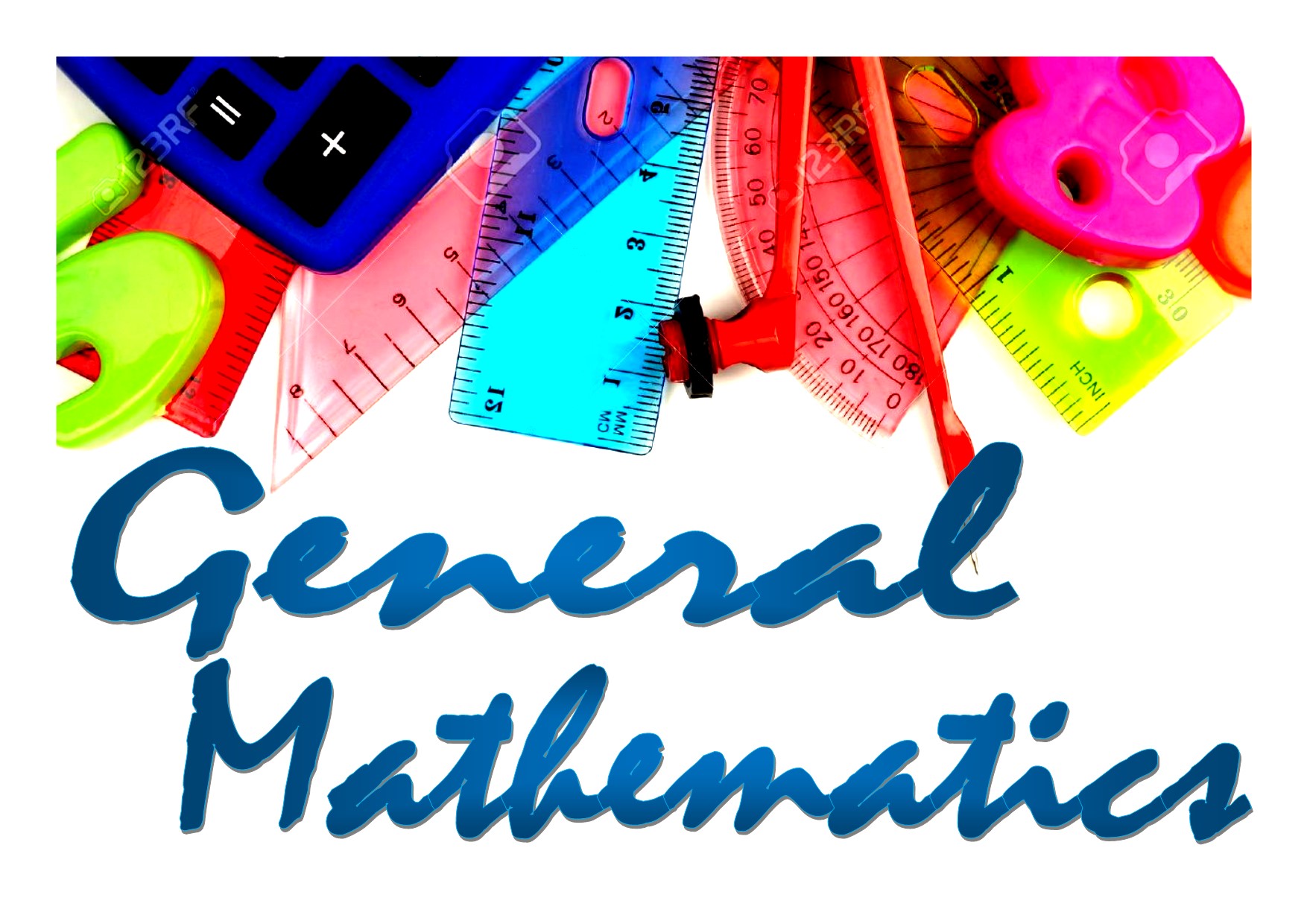
General Mathematics 11
This learning resource on General Mathematics is composed of three major chapters: functions, business mathematics, and logic. Each lesson begins with a pre-assessment and ends with a post assessment. The main part of the lesson presents important ideas and provides several solved examples. Explanations to basic properties, the rationale for mathematical procedures, and the derivation of important formulas are also provided.
The chapters on functions are an extension of the functions learned in Junior High School, where the focus was primarily on linear, quadratic, and polynomial functions. In Grade 11, learners will be exposed to other types of functions such as piecewise, rational, exponential, and logarithmic functions. Related topics such as solving equations and inequalities, as well as identifying the domain, range, intercepts, and asymptotes are also included.
The chapters on business mathematics in Grade 11 may be learners' first opportunity to be exposed to topics related to financial literacy. Here, they learn about simple and compound interest, annuities, loans, stocks, and bonds. These lessons can hopefully prepare learners to analyze business-related problems and make sound financial decisions.
The final chapter on logic exposes learners to symbolic forms of propositions (or statements) and arguments. Through the use of symbolic logic, learners should be able to recognize equivalent propositions, identify fallacies, and judge the validity of arguments. The culminating lesson is an application of the rules of symbolic logic, as learners are taught to write their own justifications to mathematical and real-life statements.

Grade 6- Quarter I_PE 6-Gabriel O. Ganawed
This module contains the fourth lesson in Physical Education for Grade 6 in the First Quarter, nature and background of the games. Read carefully the instructions before doing the activities given in this module. There are different activities you will be answering like pretest, follow-up activities, enrichment, , application, assessment and additional activity to insure mastery of the lesson after short discussions.
This module can be used for home schooling or home study with little supervision from parent or adult or older brother or sister.
Content: Assessment of physical activities and physical fitness
Content Standard: The learner demonstrates understanding of participation and assessment of physical activity and physical fitness.
Performance Standards: The learner participates and assesses performance in physical activities and assesses physical fitness.
Learning Objectives: Explains the nature/background of the games. PE6GS-Ib-1

Grade 7 TLE-Technical Drafting-305158 Angeline Patangan
This is an exploratory and introductory course that leads to a Technical Drafting National Certificate Level II (NC II). It covers five (5) common competencies that a Grade 7/Grade 8 Technology and Livelihood Education (TLE) student ought to possess, namely: 1) use of tools and equipment; 2) maintaining tools, drawing instruments, equipment, and paraphernalia; 3) performing mensuration and calculation; 4) interpreting technical drawing and plans; and 5) practicing Occupational Health and Safety (OHS) procedures.
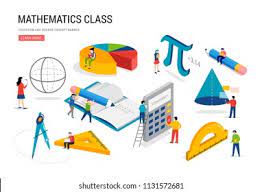
Grade 9
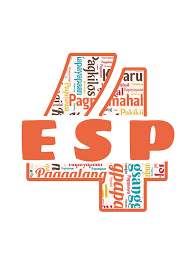
LTCS EDUKASYON SA PAGPAPAKATAO GRADE 4 - FERN
Mabuhay!
Maligayang pagbabalik sa pag-aaral. Inaasahang bawat isa ay handa sa mga aralin natin.
Ang Edukasyon sa Pagpapakatao ay isa sa walong asignatura sa Ikaapat na Baitang.
MAPEH Grade 5 135524 ICS
Identifies visually and aurally the kinds of notes and rests in a song
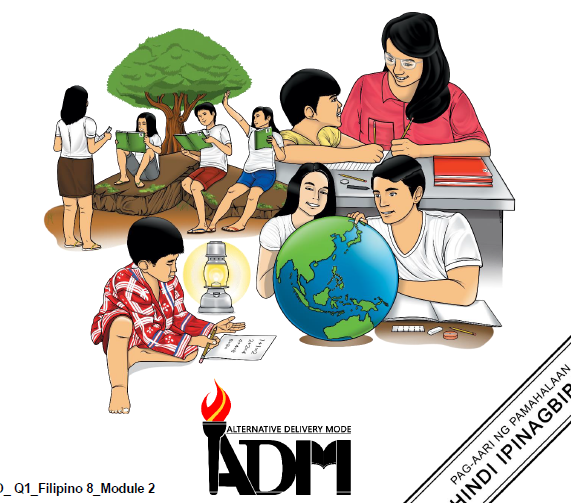
Matatalinghagang Pahayag at Eupemistiko o Masining na Pahayag
Sa pagtatapos ng ating paglalakbay, inaasahan na ikaw ay:
• Nabibigyang-kahulugan mo ang mga talinghaga, eupemistiko o masining na pahayag sa mga tula, balagtasan, alamat/ maikling kuwento, epiko ayon sa mga kasingkahulugan at kasalungat na kahulugan. F8PT-Ia-c-19
Mga tiyak na layunin:
1. Nabibigyang kahulugan ang talinghaga, eupemistiko o mainsing na pahayag sa tula;
2. Natutukoy ang mga matatalinghagang pahayag sa mga piling bahagi ng akda;
3. Matukoy ang kasingkahulugan at kasalungat ng salita;
4. Maibigay ang eupemistikong pahayag sa mga salitang bulgar;
5. Makapagsaliksik tungkol sa kadalasang matatalinghang salita na ginamit sa pagpayo o pangaral ng kanilang mga magulang sa kanilang panahon.
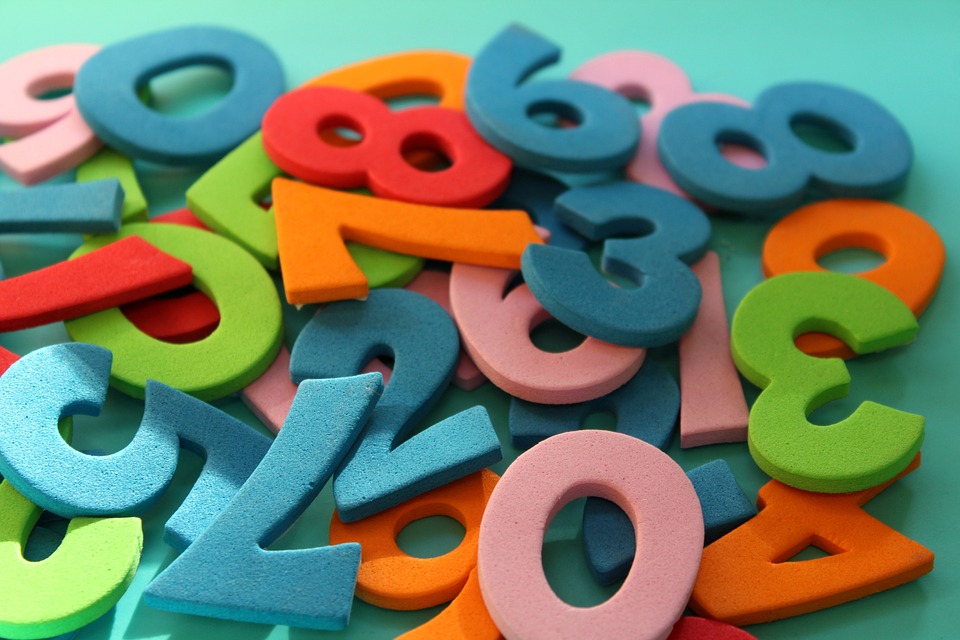
Mathematics -Grade 1- 219528- JASSEL B. OSTING
This provides learners with a solid foundation in whole numbers, addition, subtraction, multiplication, division — which help young learners build the foundation to successfully apply more demanding math concepts and procedures, and move into applications.

Mathematics -Grade 11 - 305154 - Geraldino
At the end of the course, the students must know how to solve problems involving rational, exponential and logarithmic functions; to solve business-related problems; and to apply logic to real-life situations.
MathematicsOrdinal Numbers
PREFACE
This module is a project of the Curriculum Implementation Division
particularly the Learning Resource Management and Development Unit,
Department of Education, Schools Division of Apayao - CAR which is in response
to the implementation of the K to 12 Curriculum.
This Learning Material is a property of the Department of Education - CID,
Schools Division of Apayao - CAR. It aims to improve learners’ performance
specifically in Mathematics.
Date of Development : september 2021
Resource Location : Sta. Marcela West Central Elementary
School. Sta. Marcela District, SDO-Apayao,
CAR
Learning Area : Mathematics
Grade Level : 2
Learning Resource Type : Module
Language : Iloko
Quarter/Week : Q1/W4
Learning Competency/Code : Identifies ordinal numbers from 1st through the
20th object with emphasis on the 11th to 20th
object in a given set from a given point of
reference. M2NS-Ie-16.2
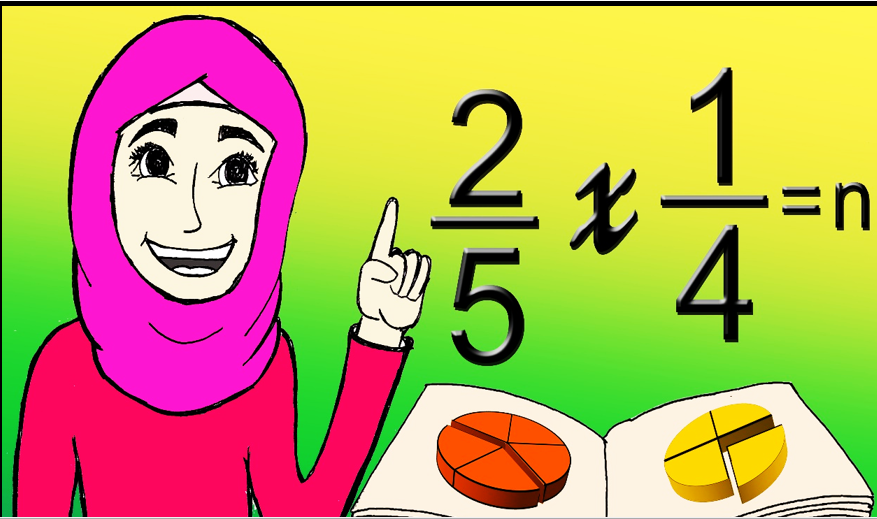
Multiplication and Division of Fraction
This course is applicable for Grades 4 to Grade 6.
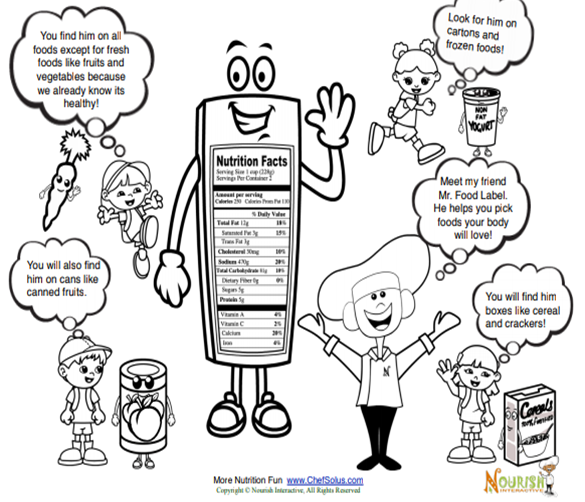
Pangkalusugan - Grade IV - 135495 Kristy Venus L. Pacio
Ang maayos na kalusugan ng tao ay nababatay sa wastong pagkain o nutrisyon. Ang wastong nutrisyon ay ang pagkain ng tamang uri ng mga pagkain at sapat na dami na kailangan ng katawan. Nangangailangan ang katawan ng balanseng pagkain upang mapanatiling malusog. Ang sustansyang kailangan ng katawan ay makukuha sa pagkain.
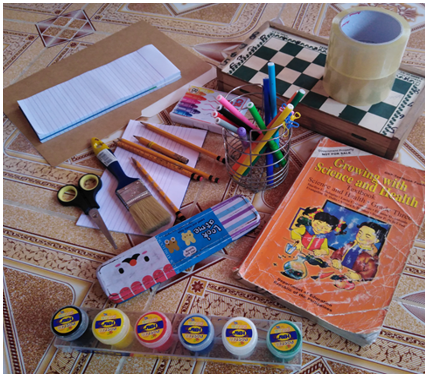
Science Grade 3 135524 ICS
Describe different objects based on their characteristics (e.g. Shape, Weight, Volume, Ease of flow); S3MT-Ia-Ib-1
* Identify different solids.
*
Group solids according to color, size, shape, and texture.
*
Describe the different solids based on their color, size, shape,
and texture.
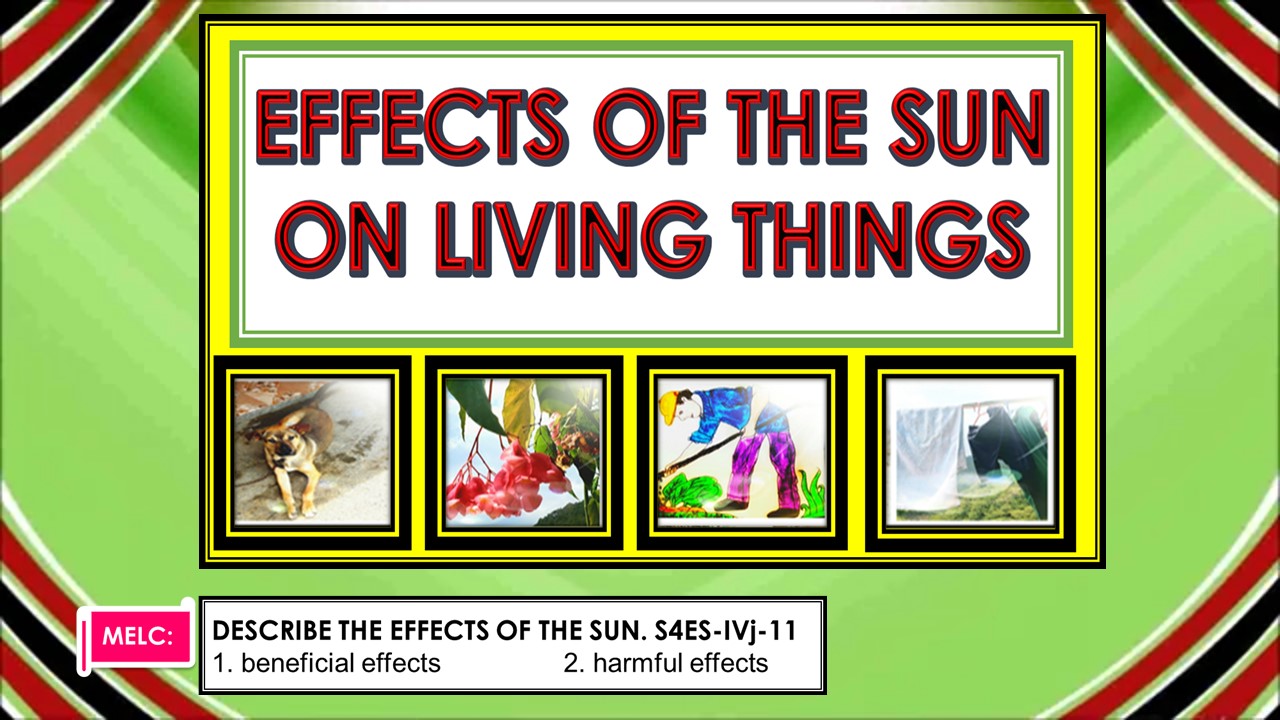
Science_Grade_4_135563BBBS
At the end of Grade 6, the learners
should have developed the essential
skills of scientific inquiry – designing
simple investigations, using appropriate
procedure, materials and tools to gather
evidence, observing patterns,
determining relationships, drawing
conclusions based on evidence, and
communicating ideas in varied ways to
make meaning of the observations
and/or changes that occur in the
environment. The content and skills
learned will be applied to maintain good
health, ensure the protection and
improvement of the environment, and
practice safety measures.

Technical Drafting 7/8
This module is a project of the Curriculum Implementation Division particularly the Learning Resource Management and Development Section, Department of Education, Schools Division of Benguet, Cordillera Administrative Region which is in response to the implementation of the K to 12 Curriculum.
This learning material in Maintain Hand Tools, Drawing Instruments, Equipment and Paraphernalia can be delivered with little supervision from parents or adults since it is designed in consideration of the assumed general level of understanding of grade 7/8 learners.

TLE-ICT-TECHNICAL DRAFTING-(Angeline Patangan)
This is an exploratory and introductory course that leads to a Technical Drafting National Certificate Level II (NC II). It covers five (5) common competencies that a Grade 7/Grade 8 Technology and Livelihood Education (TLE) student ought to possess, namely: 1) use of tools and equipment; 2) maintaining tools, drawing instruments, equipment, and paraphernalia; 3) performing mensuration and calculation; 4) interpreting technical drawing and plans; and 5) practicing Occupational Health and Safety (OHS) procedures.
The preliminaries of this exploratory course include the following: 1) discussion of the relevance of the course, 2) explanation of key concepts relative to the course, and 3) exploration of career opportunities.

TLE-ICT-TECHNICAL DRAFTING(ANGELINE PATANGAN)
This is an exploratory and introductory course that leads to a Technical Drafting National Certificate Level II (NC II). It covers five (5) common competencies that a Grade 7/Grade 8 Technology and Livelihood Education (TLE) student ought to possess, namely: 1) use of tools and equipment; 2) maintaining tools, drawing instruments, equipment, and paraphernalia; 3) performing mensuration and calculation; 4) interpreting technical drawing and plans; and 5) practicing Occupational Health and Safety (OHS) procedures.
The preliminaries of this exploratory course include the following: 1) discussion of the relevance of the course, 2) explanation of key concepts relative to the course, and 3) exploration of career opportunities.
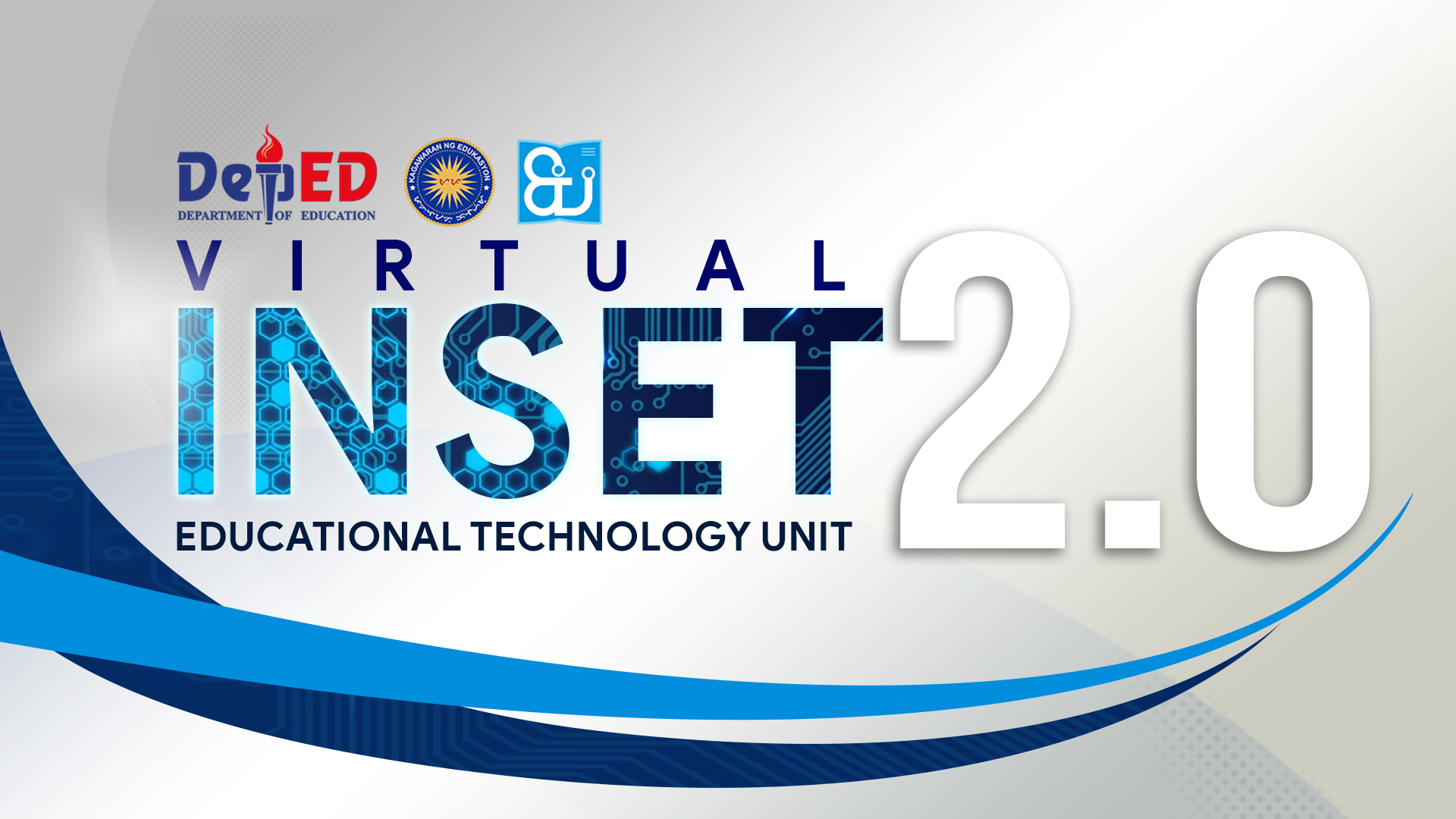
Virtual In-Service Training 2.0
1. Capacitate teachers in using different online modality platforms that include DepEd Learning Management System, DepEd COmmons, DepEd Online (FB Page, Youtube, ETULAY Tutorial Session), DepEd TV, and DepEd Radio
2. Provide awareness and proper handling of technology tools in delivering instruction in synchronous and asynchronoys format.
3. Learn and apply different components of cyber wellness (data privac, netiquette, and troubleshooting).
4. Teach emerging technology tools and applications to maximize the use of cross-platform operating system.
5. Inspire teachers through guided programs to innovate and upgrade their skills in the use of different solutions and in aquiring international certification under Microsoft, Adobe, and Google.
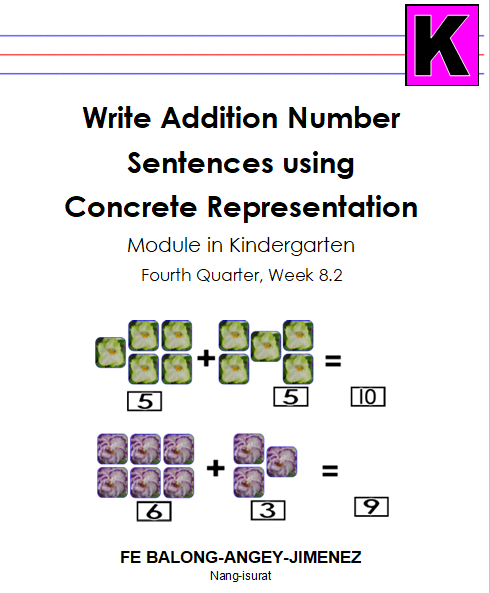
Write Addition Number Sentences using Concrete Representation
This module is a project of the Curriculum Implementation Division particularly the Learning Resource Management and Development Unit, Department of Education, Schools Division of Benguet which is in response to the implementation of the K to 12 Curriculum. It was based from Kindergarten Teacher’s Guide and Standards and Competencies for Five-Year-Old Filipino Children, 2017 of the L to 12 Program of the Department of Education.
It consist varied and appropriate activities that aims to develop the necessary skills of a Kindergarten learner in Quarter 4, Week 10 lessons and objectives are based from the Most Essential Learning Competencies (MELC).
This Learning Material is a property of the Department of Education-CID, Schools Division of Benguet. It aims to improve student’s performance specifically in Language.
Date of Development : September 2021
Resource Location : Benguet Division-Mankayan District
Learning Area : Kindergarten
Grade Level : Kindergarten
Learning Resource Type : Module
Language : Kankanaey
Quarter/Week : Quarter 4/Week 8.2
Learning Competencies and Code : Write addition and subtraction number sentences using concrete representations.
MKAT-00-10

